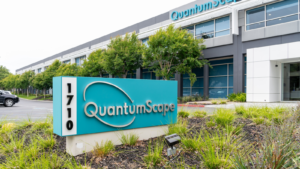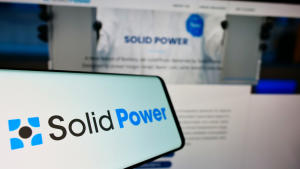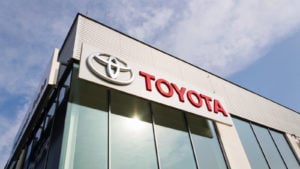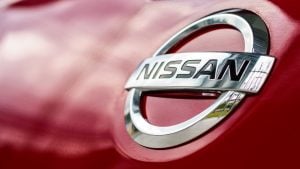New approaches to the creation of large-scale production processes and the enhancement of battery capability are the main areas of concern for companies. Advancements include the choice of materials for the solid electrolyte and the decrease of the production costs. For example, some firms are developing technologies that can leverage existing lithium-ion production facilities, which can reduce capital costs and time to market.
Many leading automobile and technology organizations are spending huge sums to develop solid state batteries and are entering into alliances to fast-track the research. For instance, the links between automobile companies and battery producers will help in the development and integration of solid state batteries in electric vehicles.
I foresee great potential for investors to get impressive gains from investing in solid-state battery stocks. Here are three companies that are worthy of investor attention.
QuantumScape (QS)

QuantumScape (NYSE:QS) is at the forefront of solid-state battery technology and is a potential threat to traditional battery technology in the electric vehicle industry.
The battery maker has already achieved several important technical milestones, such as proving their material’s ability to withstand more than 1,000 charge-discharge cycles, maintaining more than 95 percent of its initial capacity.
An EV charged with QuantumScape’s batteries could drive 500,000 kilometers before the range started to degrade noticeably. Also, the company achieved its primary 2024 goal early, having begun customer shipments of the Alpha-2 prototype cells.
I think that QS is one of those solid-state battery stocks investors should have on their radar. Given its disruptive potential as well as the promising technical milestones achieved, QuantumScape could potentially become a multi-bagger if the pieces fall into place.
Solid Power (SLDP)

Colorado-based startup Solid Power (NASDAQ:SLDP) is another solid-state battery stock with the power to disrupt the EV market. Due to its three well-placed partners BMW (OTCMKTS:BMWYY), Ford (NYSE:F) and SK On, Solid Power is well-positioned and supported to take their technology to the market. BMW has tested Solid Power’s Sample A-2 silicon-anode batteries and intends to produce a demo car with the technology in the future.
From a financial perspective, Solid Power is also in good shape. It has $146 million in cash and $232 million in long-term investments, which will be enough to support operations till 2026. The company expects to have a lower cash burn rate in the future as it reaches certain development markers with its partners.
SLDP’s risk profile is slightly lower than many other solid-state battery stocks in my opinion given the liquidity on its balance sheet and its existing partnerships.
Toyota (TM)

Toyota (NYSE:TM) has heavily invested in solid-state battery technology, which can provide a big boost to the company’s electric vehicle ambitions. The Japanese automaker is one of the key players and plans to start the mass production of the batteries for their EVs by 2027 at the earliest.
Toyota’s executives say the new touch-and-go batteries offer a 750-mile range per charge while only taking 10 minutes to charge. This would solve some EV buyer concerns such as range and charging time. Toyota plans to work with Idemitsu Kosan (OTCMKTS:IDKOY) to manufacture the solid-state batteries.
It remains unclear when solid-state batteries will become commercially available on a larger scale. Toyota’s current technological advancement and collaborations, however. position the company to seize the opportunity of this future-generation battery technology. As the world’s biggest automaker, Toyota can promote solid-state batteries as one of the most competitive solutions for EVs today.
Panasonic (PCRFY)

Panasonic (OTCMKTS:PCRFY) is a key player in the battery industry due to its research and development in solid-state battery technology. Yet it isn’t currently focusing EV solid-state batteries. Instead, the company plans to bring the technology to the market for drones and industrial robots by 2029. This could be significant.
It is claimed the company has solved a major drawback of solid-state batteries, which is their limited usage life. Panasonic’s new batteries are solid-state and they can handle many thousands of charging and discharging cycles.
Indeed, Panasonic may not be able to enter the EV market with solid-state batteries as early as Toyota. However, Panasonic’s technological developments and production experience put the company in a good place to leverage the transition to solid-state batteries as the battery technology of choice across numerous industries. It makes Panasonic one of those solid-state battery stocks to buy.
Albemarle (ALB)

Albemarle (NYSE:ALB) is one of the largest lithium producers in the world despite not owning a battery factory. Rather it is scaling lithium extraction from its current operations in Arkansas.
The company foresees a 2.5x increase in lithium demand from 2024 to 2030. That will require significant new lithium production capacity. That is a key reason it is still one of the top solid-state battery stocks to consider.
But there’s more to be bullish about when it comes to ALB. The miner has strong lithium reserves, a fortress-like balance sheet and debt that is declining. It is therefore well positioned to manage near-term lithium price risks. Additionally, Albemarle is a prominent global lithium producer that can create alliances with new solid-state battery developers. It guarantees control of the crucial lithium supply when the new generation of this technology picks up momentum.
Arcadium Lithium (ALTM)

Arcadium Lithium (NYSE:ALTM) is well-placed to benefit from lithium’s requirement as a key raw material for developing solid-state batteries. It is a leader in the production of lithium compounds and chemicals such as lithium carbonate and lithium hydroxide. I think Arcadium is in a good position to meet the need for raw materials for solid-state batteries.
Arcadium owns 100% of lithium projects located in Argentina, including the Fenix, Olaroz, Sal De Vida and Cauchari projects. It also owns a lithium hydroxide facility in Bessemer City. Moreover, it has joint ventures in China, Japan and Canada. This gives it diversification in geography and proximity to low-cost production sources. That makes Arcadium a suitable partner for lithium for carmakers and battery producers as they scale up the production of solid-state batteries.
After recently completing its merger, ALTM could be on its way to realizing synergies and extracting the most value from its asset base. It means it could also potentially be undervalued at under $4 per share.
Nissan (NSANY)

Nissan (OTCMKTS:NSANY) is another automaker developing solid-state batteries. They are expected to provide several breakthrough improvements. In particular, the offer twice the energy density of current lithium-ion batteries, better performance that results in faster charging times and reduced costs from using relatively cheaper materials. This technology will be applied across numerous vehicle types, including pickup trucks. It will help the company bring its EVs up to par.
Building on its experience with the Leaf model, Nissan is well-prepared to bring this revolutionary solid-state battery to the market.
Toyota has faced challenges concerning the timelines of solid-state batteries. Nissan’s target of 2028, on the other hand, and its new pilot production line shows Nissan might be in a position to overtake the competition in this important next-gen battery race.
This gives NSANY a very attractive growth angle for investors in addition to being one of the most popular car manufacturers in the world.
On the date of publication, Matthew Farley did not have (either directly or indirectly) any positions in the securities mentioned in this article. The opinions expressed are those of the writer, subject to the InvestorPlace.com Publishing Guidelines.
On the date of publication, the responsible editor did not have (either directly or indirectly) any positions in the securities mentioned in this article.
Matthew started writing coverage of the financial markets during the crypto boom of 2017 and was also a team member of several fintech startups. He then started writing about Australian and U.S. equities for various publications. His work has appeared in MarketBeat, FXStreet, Cryptoslate, Seeking Alpha, and the New Scientist magazine, among others.
